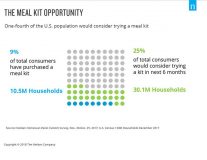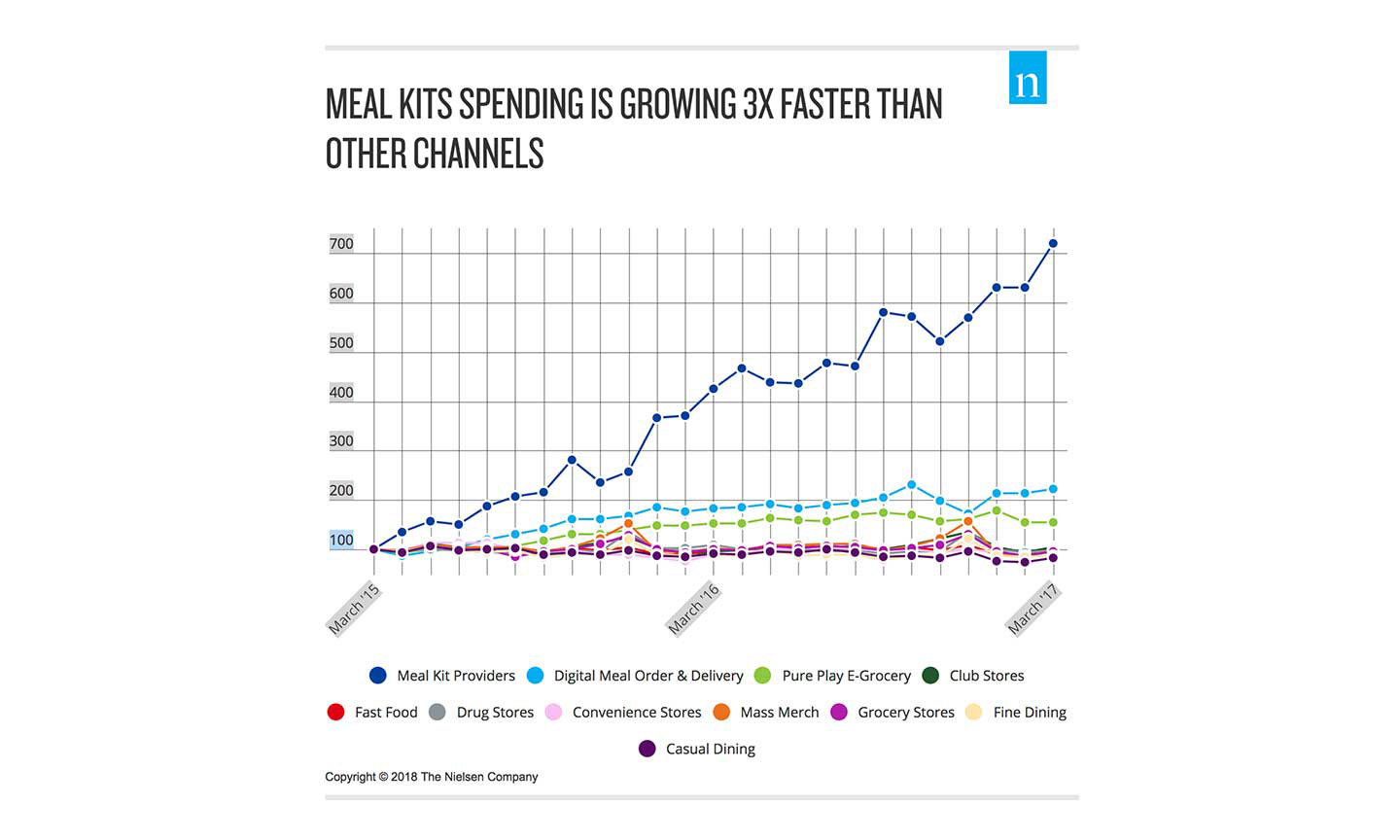While the food retail landscape isn’t one that sees an over-abundance of frequent, market-shifting innovation, meal kits are proving to be just that, according to global information and measurement company Nielsen. In just a few short years, they have carved out a unique—and profitable—niche in the U.S. grocery landscape. And what’s more, they’re no longer the exclusive domain of innovative start-ups aiming to deliver fresh, time-saving options to time-strapped consumers’ doorsteps.
Capitalizing on consumer desires for fast and fresh, in addition to the growing popularity of pre-portioned ingredients for complete meal prep at home, traditional retailers also are garnering big success with a range of in-store meal kit offerings. Notably, in the year ended 2017, in-store meal kits generated $154.6 million in sales, posting growth of more than 26 percent year-over-year. For context, total brick-and-mortar sales for center store edibles (grocery, dairy, frozen foods) dipped 0.1 percent last year to $374 billion.
 As retailers continue exploring options in the meal kit space, it’s important to understand who their customers—current and potential—are. Overall, 9 percent of Americans say they’ve purchased a meal kit in the last six months—that’s 10.5 million households. What’s more, 25 percent of consumers say they would consider trying a meal kit in the next six months—that’s more than 30 million households.
As retailers continue exploring options in the meal kit space, it’s important to understand who their customers—current and potential—are. Overall, 9 percent of Americans say they’ve purchased a meal kit in the last six months—that’s 10.5 million households. What’s more, 25 percent of consumers say they would consider trying a meal kit in the next six months—that’s more than 30 million households.
Of the 9 percent of Americans who have tried a meal kit, 6 percent have purchased exclusively online. And as a result, online meal kit companies are seeing tremendous growth.
In looking at the various food channel options consumers have to choose from, sales across the mature options, such as restaurants and traditional food outlets, have trended in line with one another over the past two years. Some of the newer options, meal kits, digital delivery and e-grocery, are bucking the norms, with pure-play meal kits garnering three times the growth of all other channels.
Getting back to meal kit shoppers, Nielsen recently conducted an analysis of its “What’s Cooking” consumer segmentation to determine which consumers groups are avid meal kit buyers. The analysis found that more than one-fourth (26 percent) of meal kit users classify themselves as gourmet cooks. Comparatively, only 16 percent of U.S. consumers consider themselves gourmet cooks, highlighting the notable appeal of meal kits to this consumer segment. On the flip side, 15 percent of Americans consider themselves frozen foodies, yet only 9 percent of frozen food consumers are meal kit users.
Digging into what meal kit buyers look for in the offerings they purchase, almost 60 percent say value for the money is extremely important, and almost half (49 percent) say low-cost items are important. In terms of what they experience across the meal kit landscape, 56 percent of consumers disagree that meal kit services are affordable for everyone. For retailers and pure-play meal kit providers alike, this insight suggests that they need to clearly articulate the value their offerings provide when pitted against traditional options.
As retailers look at the potential in the meal kit space, they will need to understand the attributes that customers look for and develop offerings that clearly highlight their value when compared against more traditional offerings.
Nielsen has debuted a new ebook, The Meal Kit Opportunity, that contains additional insights about meal kits, available here.
Keep reading:
South Dakota Grocer Launches Meal Kits, Sells Out In Four Days
https://www.theshelbyreport.com/2018/03/05/walmart-rolling-out-meal-kits-nationwide/
Meijer Offers ‘Meal Inspirations’ Kits To Cut Down On Recipe Prep Time

